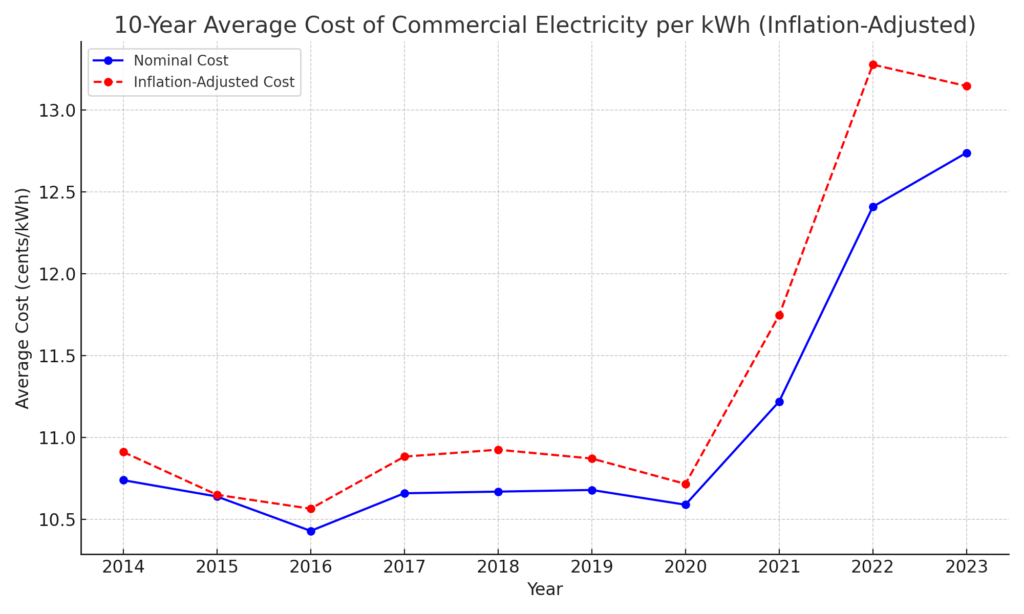Electricity prices can be unpredictable. Fluctuations in fuel prices, regulatory changes, and supply-demand dynamics can cause significant volatility. This volatility impacts business expenses, making budgeting challenging. Locking in commercial electric rate contracts for commercial electricity can mitigate these risks. Let’s explore why this strategy is beneficial.
Locking In Commercial Electric Rate Contracts: A Strategic Move for Business Owners
Price Volatility and Stability
Electricity prices often change without warning. These changes can disrupt your budget and cash flow. Fixed-rate contracts shield your business from such surprises. By locking in rates, you secure stable and predictable energy costs. This stability is crucial for financial planning and resource allocation.
Cost Savings Over Time
Securing a fixed rate now can lead to significant savings. If market prices rise, your locked-in rate stays the same. This means you pay less for electricity compared to fluctuating market rates. These savings can be substantial, especially for businesses with slim profit margins.
The Power of Predictability
Predictable energy costs simplify budgeting and financial forecasting. Knowing your expenses in advance allows for more effective planning. This predictability supports strategic decisions and long-term investments. Your business can grow with confidence, backed by stable energy costs.
Renewal and Extension Benefits
You don’t have to wait for your current contract to expire to secure future rates. Businesses can negotiate new contracts to extend existing terms. This proactive approach ensures continuous protection against price hikes. By locking in rates early, you maintain cost predictability and benefit from potential market advantages.
Analyzing Inflation-Adjusted Costs
Understanding the impact of inflation on electricity costs is essential. Here are the inflation-adjusted costs for commercial electricity per kWh over the past 10 years:
Here are the inflation-adjusted cost numbers for each year, calculated using the correct method where each year’s nominal cost is adjusted by that year’s specific inflation rate:
| Year | Nominal Cost (cents/kWh) | Inflation Rate (%) | Inflation-Adjusted Cost (cents/kWh) |
| 2014 | 10.74 | 1.6 | 10.91184 |
| 2015 | 10.64 | 0.1 | 10.65064 |
| 2016 | 10.43 | 1.3 | 10.56559 |
| 2017 | 10.66 | 2.1 | 10.88386 |
| 2018 | 10.67 | 2.4 | 10.92608 |
| 2019 | 10.68 | 1.8 | 10.87224 |
| 2020 | 10.59 | 1.2 | 10.71708 |
| 2021 | 11.22 | 4.7 | 11.74734 |
| 2022 | 12.41 | 7 | 13.2787 |
| 2023 | 12.74 | 3.2 | 13.14768 |
These inflation-adjusted costs reflect the nominal cost of electricity adjusted by the specific inflation rate for each respective year.
These adjusted costs reflect the true price of electricity, considering inflation. Locking in rates protects your business from these increasing costs.
Visualizing the Data
The graph shows both nominal and inflation-adjusted costs. The blue line represents nominal costs, while the red dashed line shows inflation-adjusted costs. This visualization highlights the benefits of locking in rates. Over time, inflation-adjusted costs increase, showing the rising expense of electricity. A fixed-rate contract mitigates these increases, providing financial stability.

Conclusion
Locking in commercial electric rate contracts for commercial electricity is a smart strategy. It offers protection against price volatility, ensures budget stability, and can lead to significant cost savings. By renewing and extending contracts before they expire, businesses can maintain these benefits continuously. This proactive approach to energy management supports long-term planning and strategic growth.
In conclusion, fixed-rate contracts are not just a financial tool but a strategic asset for your business. Secure your future today by locking in your electricity rates.
About Energywise
Energywise Solutions offers a comprehensive mix of solutions designed to help business owners lower operating costs and improve the efficiency of their facilities.
Working directly with operators and developers, our solutions include utility-based incentives for energy upgrades, and brokered discounts on electric and gas pricing in deregulated utility markets.
We also work with the design, development and constructions team of architects, interior designers, engineers, and contractors to specify and supply LED lighting systems, lighting controls and automated building controls.
Scott Van Kerkhove is the CEO of Energywise and writes on topics and issues surrounding the lighting and controls industry, energy management, profitability and sustainability. Find me on LinkedIn – Author: Scott Van Kerkhove







